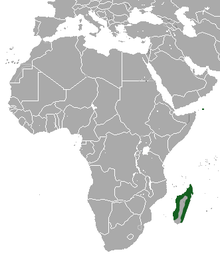| Madagascan pygmy shrew | |
|---|---|
| Scientific classification | |
| Domain: | Eukaryota |
| Kingdom: | Animalia |
| Phylum: | Chordata |
| Class: | Mammalia |
| Order: | Eulipotyphla |
| Family: | Soricidae |
| Genus: | Suncus |
| Species: | S. madagascariensis
|
| Binomial name | |
| Suncus madagascariensis (Coquerel, 1848)
| |

| |
| Madagascan pygmy shrew range | |

| |
| Madagascan pygmy shrew range in Madagascar | |
| Synonyms | |
|
Suncus etruscus (Savi, 1822) | |
The Madagascan pygmy shrew (Suncus madagascariensis) is a species of mammal in the family Soricidae.[2] It is the only known Malagasy shrew.[1]
YouTube Encyclopedic
-
1/3Views:588 731562192 342
-
SMALLEST Animals In The World!
-
The TINIEST ANIMALS In The World!
-
How Did You Get Here?! (Unexpected Ways Species Travel the World)
Transcription
Taxonomy
Some taxonomists regard it as conspecific with the widely distributed Etruscan shrew, the smallest known mammal by mass,[1][2] and likely to have been introduced to Madagascar from India or Southeast Asia by humans.[3] It is found in Madagascar and the Comoros, at altitudes from sea level to 1500 m.[1]
Distribution and habitat
It is thought to be more common in the less humid western and southern parts of Madagascar.[1] This shrew may also be present on Socotra.[2] The species is found primarily in forests.
Diet and behaviour
It is presumed to be solitary, nocturnal and insectivorous, like its relatives.[1] The litter size is one or two.[1] It is threatened by logging and other forms of deforestation.[1]
References
- ^ a b c d e f g h Aulagnier, S.; Hutterer, R.; Jenkins, P.; Bukhnikashvili, A.; Kryštufek, B.; Kock, D. (2017). "Suncus etruscus". The IUCN Red List of Threatened Species. 2017. IUCN: e.T90389138A22288134. doi:10.2305/IUCN.UK.2017-2.RLTS.T90389138A22288134.en. Retrieved 20 February 2019.
- ^ a b c Hutterer, R. (2005). "Order Soricomorpha". In Wilson, D.E.; Reeder, D.M (eds.). Mammal Species of the World: A Taxonomic and Geographic Reference (3rd ed.). Johns Hopkins University Press. p. 259. ISBN 978-0-8018-8221-0. OCLC 62265494.
- ^ Omar, H.; Adamson, E.A.S.; Bhauur, S.; Goodman, S.M.; Soarimalala, V.; Hashim, R.; Ruedi, M. (2011). Phylogenetic relationships of Malayan and Malagasy pygmy shrews of the genus Suncus (Soricomorpha: Soricidae) inferred from mitochondrial cytochrome b gene sequences Archived 12 August 2017 at the Wayback Machine. The Raffles Bulletin of Zoology 59(2): 237–243.
| Suncus madagascariensis | |
|---|---|
This article about a white-toothed shrew is a stub. You can help Wikipedia by expanding it. |

